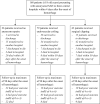Clinical characteristics and factors relating to poor outcome in patients with aneurysmal subarachnoid hemorrhage in Vietnam: A multicenter prospective cohort study
- PMID: 34388213
- PMCID: PMC8362943
- DOI: 10.1371/journal.pone.0256150
Clinical characteristics and factors relating to poor outcome in patients with aneurysmal subarachnoid hemorrhage in Vietnam: A multicenter prospective cohort study
Abstract
Background: The prevalence of risk factors for poor outcomes from aneurysmal subarachnoid hemorrhage (SAH) varies widely and has not been fully elucidated to date in Vietnam. Understanding the risk and prognosis of aneurysmal SAH is important to reduce poor outcomes in Vietnam. The aim of this study, therefore, was to investigate the rate of poor outcome at 90 days of ictus and associated factors from aneurysmal SAH in the country.
Methods: We performed a multicenter prospective cohort study of patients (≥18 years) presenting with aneurysmal SAH to three central hospitals in Hanoi, Vietnam, from August 2019 to August 2020. We collected data on the characteristics, management, and outcomes of patients with aneurysmal SAH and compared these data between good (defined as modified Rankin Scale (mRS) of 0 to 3) and poor (mRS, 4-6) outcomes at 90 days of ictus. We assessed factors associated with poor outcomes using logistic regression analysis.
Results: Of 168 patients with aneurysmal SAH, 77/168 (45.8%) were men, and the median age was 57 years (IQR: 48-67). Up to 57/168 (33.9%) of these patients had poor outcomes at 90 days of ictus. Most patients underwent sudden-onset and severe headache (87.5%; 147/168) and were transferred from local to participating central hospitals (80.4%, 135/168), over half (57.1%, 92/161) of whom arrived in central hospitals after 24 hours of ictus, and the initial median World Federation of Neurological Surgeons (WFNS) grading score was 2 (IQR: 1-4). Nearly half of the patients (47.0%; 79/168) were treated with endovascular coiling, 37.5% (63/168) were treated with surgical clipping, the remaining patients (15.5%; 26/168) did not receive aneurysm repair, and late rebleeding and delayed cerebral ischemia (DCI) occurred in 6.1% (10/164) and 10.4% (17/163) of patients, respectively. An initial WFNS grade of IV (odds ratio, OR: 15.285; 95% confidence interval, CI: 3.096-75.466) and a grade of V (OR: 162.965; 95% CI: 9.975-2662.318) were independently associated with poor outcomes. Additionally, both endovascular coiling (OR: 0.033; 95% CI: 0.005-0.235) and surgical clipping (OR: 0.046; 95% CI: 0.006-0.370) were inversely and independently associated with poor outcome. Late rebleeding (OR: 97.624; 95% CI: 5.653-1686.010) and DCI (OR: 15.209; 95% CI: 2.321-99.673) were also independently associated with poor outcome.
Conclusions: Improvements are needed in the management of aneurysmal SAH in Vietnam, such as increasing the number of aneurysm repairs, performing earlier aneurysm treatment by surgical clipping or endovascular coiling, and improving both aneurysm repairs and neurocritical care.
Conflict of interest statement
The authors have declared that no competing interests exist.
Figures
Similar articles
-
Endovascular coiling versus neurosurgical clipping for people with aneurysmal subarachnoid haemorrhage.Cochrane Database Syst Rev. 2018 Aug 15;8(8):CD003085. doi: 10.1002/14651858.CD003085.pub3. Cochrane Database Syst Rev. 2018. PMID: 30110521 Free PMC article.
-
Ultra-early endovascular embolization of ruptured cerebral aneurysm and the increased risk of hematoma growth unrelated to aneurysmal rebleeding.J Neurosurg. 2013 May;118(5):1003-8. doi: 10.3171/2012.11.JNS12610. Epub 2012 Dec 14. J Neurosurg. 2013. PMID: 23240702
-
Thick and diffuse cisternal clot independently predicts vasospasm-related morbidity and poor outcome after aneurysmal subarachnoid hemorrhage.J Neurosurg. 2020 May 22;134(5):1553-1561. doi: 10.3171/2020.3.JNS193400. Print 2021 May 1. J Neurosurg. 2020. PMID: 32442971
-
No Disparity in Outcomes Between Surgical Clipping and Endovascular Coiling After Aneurysmal Subarachnoid Hemorrhage.World Neurosurg. 2018 Dec;120:e318-e325. doi: 10.1016/j.wneu.2018.08.060. Epub 2018 Sep 21. World Neurosurg. 2018. PMID: 30244185
-
In-hospital mortality and poor outcome after surgical clipping and endovascular coiling for aneurysmal subarachnoid hemorrhage using nationwide databases: a systematic review and meta-analysis.Neurosurg Rev. 2020 Apr;43(2):655-667. doi: 10.1007/s10143-019-01096-2. Epub 2019 Apr 2. Neurosurg Rev. 2020. PMID: 30941595
Cited by
-
Neurologic Injury-Related Predisposing Factors of Post-Traumatic Stress Disorder: A Critical Examination.Biomedicines. 2023 Oct 9;11(10):2732. doi: 10.3390/biomedicines11102732. Biomedicines. 2023. PMID: 37893106 Free PMC article. Review.
-
Predictive validity of the prognosis on admission aneurysmal subarachnoid haemorrhage scale for the outcome of patients with aneurysmal subarachnoid haemorrhage.Sci Rep. 2023 Apr 25;13(1):6721. doi: 10.1038/s41598-023-33798-5. Sci Rep. 2023. PMID: 37185953 Free PMC article.
-
Clinical Profile and Outcome in Patients with Spontaneous Subarachnoid Hemorrhage from a South Indian Tertiary Centre: A Prospective Observational Study.Asian J Neurosurg. 2023 Mar 27;18(1):80-87. doi: 10.1055/s-0043-1761234. eCollection 2023 Mar. Asian J Neurosurg. 2023. PMID: 37056879 Free PMC article.
-
Validation of the accuracy of the modified World Federation of Neurosurgical Societies subarachnoid hemorrhage grading scale for predicting the outcomes of patients with aneurysmal subarachnoid hemorrhage.PLoS One. 2023 Aug 22;18(8):e0289267. doi: 10.1371/journal.pone.0289267. eCollection 2023. PLoS One. 2023. PMID: 37607172 Free PMC article.
-
Factors related to intracerebral haematoma in patients with aneurysmal subarachnoid haemorrhage in Vietnam: a multicentre prospective cohort study.BMJ Open. 2023 Apr 21;13(4):e066186. doi: 10.1136/bmjopen-2022-066186. BMJ Open. 2023. PMID: 37085308 Free PMC article.
References
-
- Mackey J, Khoury JC, Alwell K, Moomaw CJ, Kissela BM, Flaherty ML, et al.. Stable incidence but declining case-fatality rates of subarachnoid hemorrhage in a population. Neurology. 2016;87(21):2192–7. Epub 2016/10/23. doi: 10.1212/WNL.0000000000003353 ; PubMed Central PMCID: PMC5123555. - DOI - PMC - PubMed
Publication types
MeSH terms
LinkOut - more resources
Full Text Sources
Medical


